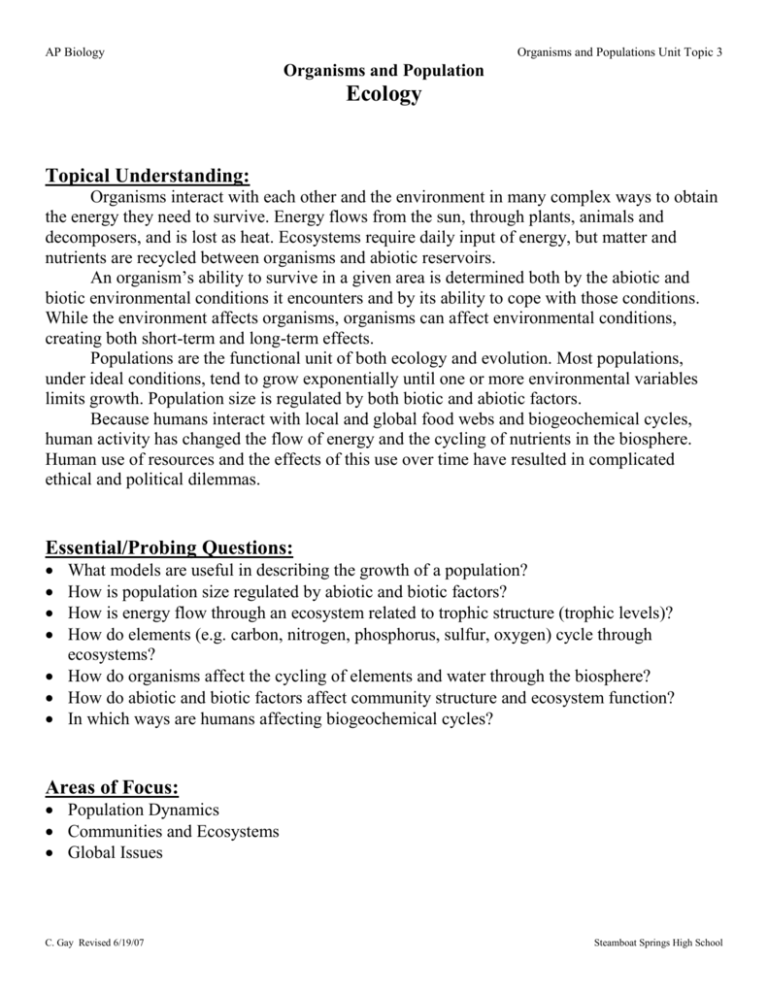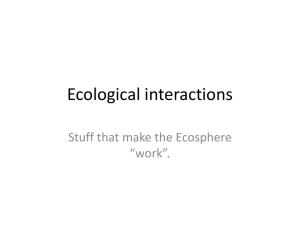Ecology
advertisement

AP Biology Organisms and Populations Unit Topic 3 Organisms and Population Ecology Topical Understanding: Organisms interact with each other and the environment in many complex ways to obtain the energy they need to survive. Energy flows from the sun, through plants, animals and decomposers, and is lost as heat. Ecosystems require daily input of energy, but matter and nutrients are recycled between organisms and abiotic reservoirs. An organism’s ability to survive in a given area is determined both by the abiotic and biotic environmental conditions it encounters and by its ability to cope with those conditions. While the environment affects organisms, organisms can affect environmental conditions, creating both short-term and long-term effects. Populations are the functional unit of both ecology and evolution. Most populations, under ideal conditions, tend to grow exponentially until one or more environmental variables limits growth. Population size is regulated by both biotic and abiotic factors. Because humans interact with local and global food webs and biogeochemical cycles, human activity has changed the flow of energy and the cycling of nutrients in the biosphere. Human use of resources and the effects of this use over time have resulted in complicated ethical and political dilemmas. Essential/Probing Questions: What models are useful in describing the growth of a population? How is population size regulated by abiotic and biotic factors? How is energy flow through an ecosystem related to trophic structure (trophic levels)? How do elements (e.g. carbon, nitrogen, phosphorus, sulfur, oxygen) cycle through ecosystems? How do organisms affect the cycling of elements and water through the biosphere? How do abiotic and biotic factors affect community structure and ecosystem function? In which ways are humans affecting biogeochemical cycles? Areas of Focus: Population Dynamics Communities and Ecosystems Global Issues C. Gay Revised 6/19/07 Steamboat Springs High School AP Biology Organisms and Populations Unit Topic 3 Knowledge: The Biosphere o Ecological hierarchies o Physical and chemical factors: solar energy, water, temperature, wind o Organism adaptations to abiotic and biotic factors o Influences of climate Aquatic Biomes o Ocean structure and composition o Freshwater biomes Terrestrial Biomes o Biomes and climate: tropical forests, savannas, desserts, chaparral, temperate grasslands, temperate forests, taiga, tundra Population Structure and Dynamics o Defining populations o Population variables: density, dispersion patterns o Population growth models: exponential growth, logistic growth models o Limits to growth: boom and bust cycles Life Histories and Their Evolution o Mortality and survivorship o Life histories: r and k selection Human Population o Ecological footprints and exponential growth o Age structures Structural Features of Communities o Definitions of communities o Competition o Predation and adaptations: mimicry models and coevolution, keystone species o Symbiotic relationships: commensalisms, mutualism, parasitism o Succession: primary vs. secondary Ecosystem Structure and Dynamics o Energy flow and chemical cycling o Trophic structure o Food webs and limiting factors o Pyramids o Biogeochemical cycles: water, carbon, nitrogen, phosphorus Ecosystem Alteration o Eutrophication o Zoned reserves Classical Concepts in Behavior o Behavior biology: genetic vs. environmental o Innate behavior and fixed action patterns o Learning: association and imitation, animal cognition Social Behavior and Sociobiology o Behavior and evolution o Biological rhythms o Kinesis vs. taxis: internal maps o Feeding behavior and cost-benefit analysis o Sociobiology: agonistic behavior, dominance hierarchies, territorial behaviors, mating behaviors o Social behavior and signaling o Altruistic acts and evolution C. Gay Revised 6/19/07 Steamboat Springs High School AP Biology Organisms and Populations Unit Topic 3 Biodiversity Crisis o Habitat destruction, introduced species, overexploitation o Biodiversity o Biological magnification o Global warming Geographic Distribution of Biogeography o Biodiversity hot spots and endemic species Conservation of Populations and Species o Endangered populations: small-population approach, declining-population approach o Fragmentation and population viability analysis Managing and Sustaining Ecosystems o Landscape ecology and gap analysis o Edges and movement corridors o Restoration ecology, bioremediation, augmentation of ecosystem processes o Sustainable development Skills: Text-based seminars Titrations C. Gay Revised 6/19/07 Steamboat Springs High School








